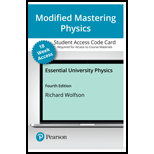
Concept explainers
You’re holding one end of a taut rope, and you can’t see the other end. You tweak the rope to give it an upward displacement, sending a pulse down the rope. A while later, a pulse comes back toward you. Its displacement is upward, but with considerably lower amplitude than the initial displacement you provided. Assuming there’s no energy loss in the rope itself, you can conclude that the far end of the rope is (a) attached to a rigid anchor point, (b) attached in such a way that it’s free to slide up and down, (c) tied to another rope with less mass per unit length, or (d) tied to another rope with more mass per unit length.
Want to see the full answer?
Check out a sample textbook solution
Chapter 14 Solutions
ESSENTIAL UNIV.PHYS.-MOD.MASTERING(18W)
Additional Science Textbook Solutions
Microbiology: An Introduction
Human Physiology: An Integrated Approach (8th Edition)
Physics for Scientists and Engineers: A Strategic Approach, Vol. 1 (Chs 1-21) (4th Edition)
Organic Chemistry (8th Edition)
Cosmic Perspective Fundamentals
- 13. After a gust of wind, an orb weaver spider with a mass of 35 g, hanging on a strand of web of length L = .420 m, undergoes simple harmonic motion (SHO) with an amplitude A and period T. If the spider climbs 12.0 cm up the web without perturbing the oscillation otherwise, what is the period of oscillation, in Hz to three significant figures?arrow_forward15. An object of mass m = 8.10 kg is attached to an ideal spring and allowed to hang in the earth's gravitational field. The spring stretches 23.10 cm before it reaches its equilibrium position. The mass then undergoes simple harmonic motion with an amplitude of 10.5 cm. Calculate the velocity of the mass in m/s at a time t= 1.00s to three significant figures.arrow_forwardplease solve and answer the question correctly. Thank you!!arrow_forward
- 18arrow_forward1. Some 1800 years ago Roman soldiers effectively used slings as deadly weapons. The length of these slings averaged about 81 cm and the lead shot that they used weighed about 30 grams. If in the wind up to a release, the shot rotated around the Roman slinger with a period of .14 seconds. Find the maximum acceleration of the shot before being released in m/s^2 and report it to two significant figures.arrow_forward16arrow_forward
- 11. A small charged plastic ball is vertically above another charged small ball in a frictionless test tube as shown in the figure. The balls are in equilibrium at a distance d= 2.0 cm apart. If the charge on one ball is tripled, find the new equilibrium distance between the balls in cm and report it to the proper number of significant figures.arrow_forward12. The electric field at a point 1.3 cm from a small object points toward the object with a strength of 180,000 N/C. Find the object's charge q, in nC to the proper number of significant figures. k = 1/4πε0 = 8.99 × 10^9 N ∙ m^2/C^2arrow_forward14. When the potential difference between the plates of an ideal air-filled parallel plate capacitor is 35 V, the electric field between the plates has a strength of 670 V/m. If the plate area is 4.0 × 10^-2 m^2, what is the capacitance of this capacitor in pF? (ε0 = 8.85 × 10^-12 C^2/N ∙ m^2)arrow_forward
- 10. A small styrofoam ball of mass 0.500 g is placed in an electric field of 1140 N/C pointing downward. What excess charge must be placed on the ball for it to remain suspended in the field? Report your answer in micro-Coulombs to three significant figures.arrow_forward2arrow_forwardplease solve and answer the question correctly. Thank you!!arrow_forward
 Principles of Physics: A Calculus-Based TextPhysicsISBN:9781133104261Author:Raymond A. Serway, John W. JewettPublisher:Cengage Learning
Principles of Physics: A Calculus-Based TextPhysicsISBN:9781133104261Author:Raymond A. Serway, John W. JewettPublisher:Cengage Learning Physics for Scientists and Engineers: Foundations...PhysicsISBN:9781133939146Author:Katz, Debora M.Publisher:Cengage Learning
Physics for Scientists and Engineers: Foundations...PhysicsISBN:9781133939146Author:Katz, Debora M.Publisher:Cengage Learning Glencoe Physics: Principles and Problems, Student...PhysicsISBN:9780078807213Author:Paul W. ZitzewitzPublisher:Glencoe/McGraw-Hill
Glencoe Physics: Principles and Problems, Student...PhysicsISBN:9780078807213Author:Paul W. ZitzewitzPublisher:Glencoe/McGraw-Hill University Physics Volume 1PhysicsISBN:9781938168277Author:William Moebs, Samuel J. Ling, Jeff SannyPublisher:OpenStax - Rice University
University Physics Volume 1PhysicsISBN:9781938168277Author:William Moebs, Samuel J. Ling, Jeff SannyPublisher:OpenStax - Rice University Physics for Scientists and Engineers, Technology ...PhysicsISBN:9781305116399Author:Raymond A. Serway, John W. JewettPublisher:Cengage Learning
Physics for Scientists and Engineers, Technology ...PhysicsISBN:9781305116399Author:Raymond A. Serway, John W. JewettPublisher:Cengage Learning College PhysicsPhysicsISBN:9781305952300Author:Raymond A. Serway, Chris VuillePublisher:Cengage Learning
College PhysicsPhysicsISBN:9781305952300Author:Raymond A. Serway, Chris VuillePublisher:Cengage Learning





